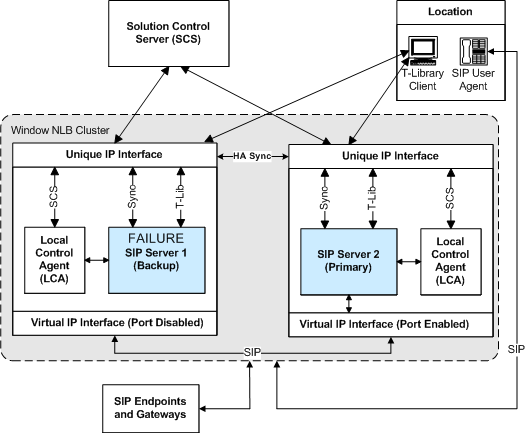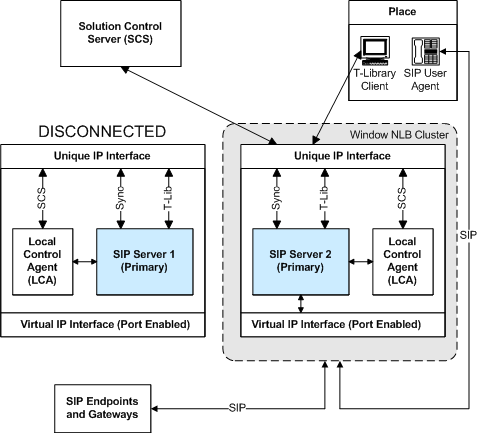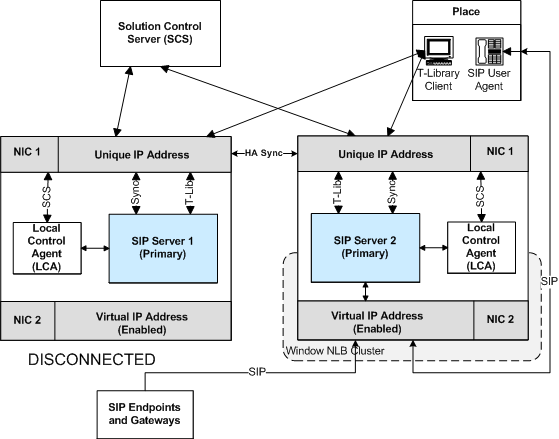Windows NLB Cluster HA Workflows
The HA Windows NLB Cluster Configuration figure shows a Windows NLB Cluster configuration prior to a switchover.
State Prior to Switchover
- SIP Server 1 is in primary mode.
- SIP Server 2 is in backup mode.
- The SIP port is enabled at the primary SIP Server (SIP Server 1).
- The SIP port is disabled at the backup SIP Server (SIP Server 2).
State After a Switchover
To see what happens in different scenarios, see the following:
|
 HA Windows NLB Cluster Configuration |
Manual-Switchover Workflow
The following steps describe a switchover workflow for a Windows NLB Cluster configuration (the HA Windows NLB Cluster Configuration After a Switchover figure represents the end state of the workflow):
- The switchover is initiated manually from the Solution Control Interface (SCI).
- Through Local Control Agent (LCA), the Solution Control Server (SCS) instructs the primary SIP Server (SIP Server 1) to go into backup mode.
- Through LCA, the SCS instructs the backup SIP Server (SIP Server 2) to go into primary mode.
- The SCS generates a log message with Event ID 00-5150 to indicate that SIP Server 2 has changed to primary mode and a log messages with Event ID 00-5151 to indicate that SIP Server 1 has changed to backup mode.
- The SCS activates the Alarm Conditions, which execute the associated Alarm Reaction scripts.
- The Alarm Reaction scripts trigger the Cluster control scripts that are configured as applications.
- The SCS instructs LCA to launch the Cluster control scripts on the SIP Server hosts.
- The Cluster control scripts run NLB utilities that disable the Virtual IP port on SIP Server 1 and enable the Virtual IP port on SIP Server 2.
|
 HA Windows NLB Cluster Configuration After a Switchover |
Primary Server-Failure Workflow
The following steps describe a primary server-failure workflow for a Windows NLB Cluster configuration (the HA Windows NLB Cluster Configuration After Primary Server Failure figure represents the end state of the workflow):
- The primary SIP Server (SIP Server 1) fails.
- LCA detects the primary SIP Server application failure and reports it to the SCS.
- Through LCA, the SCS instructs the backup SIP Server (SIP Server 2) to go into primary mode.
- The SCS generates a log message with Event ID 00-5150, to indicate that SIP Server 2 has changed to primary mode.
- The SCS activates the Alarm Condition, which executes the associated Alarm Reaction scripts.
- The Alarm Reaction scripts trigger the Cluster control scripts that are configured as applications.
- The SCS instructs LCA to launch the Cluster control scripts on the SIP Server hosts.
- The Cluster control scripts run Windows NLB utilities that disable the Virtual IP port on SIP Server 1 and enable the Virtual IP port on SIP Server 2.
|
 HA Windows NLB Cluster Configuration After Primary Server Failure |
Primary Server-Disconnected Workflow 1
The following steps describe a primary server-disconnected workflow for a Windows NLB Cluster configuration (the HA Windows NLB Cluster Configuration After a Primary Server is Disconnected figure represents the end state of the workflow):
- The SCS detects that the connection to the primary SIP Server host (SIP Server 1) has been lost.
- Through LCA, the SCS instructs the backup SIP Server (SIP Server 2) to go into primary mode.
- The SCS generates a log message with Event ID 00-5150, to indicate that SIP Server 2 has changed to primary mode.
- The SCS activates the Alarm Condition, which executes the associated Alarm Reaction scripts.
- The Alarm Reaction scripts trigger the Cluster control scripts that are configured as applications.
- The SCS instructs LCA to launch the Cluster control scripts on the SIP Server hosts.
- Because SIP Server 1 is disconnected, the Cluster control script that is used to disable the Virtual IP port on SIP Server 1 cannot be executed, and the port remains enabled. The Cluster control script is able to run on SIP Server 2 and the Virtual IP port is enabled.
|
 HA Windows NLB Cluster Configuration After a Primary Server is Disconnected |
When the connection to SIP Server 1 has been restored, the following workflow occurs (not depicted in the HA Windows NLB Cluster Configuration After a Primary Server is Disconnected figure, above):
- The SCS detects that the connection to SIP Server 1 host has been restored.
- The SCS discovers that both SIP Servers are running in primary mode.
- Through LCA, the SCS instructs SIP Server 1, whose connection was just restored, to go into backup mode.
- The SCS generates a log message with Event ID 00-5151, to indicate that SIP Server 1 has changed to backup mode.
- The SCS activates an Alarm Condition, which executes an associated Alarm Reaction script.
- The Alarm Reaction script triggers the Cluster control script that is configured as application.
- The SCS instructs LCA to launch the Cluster control script on SIP Server 1.
- The Cluster control script runs on SIP Server 1, and the Virtual IP port is disabled.
Primary Server-Disconnected Workflow 2
The following steps describe a primary server-disconnected workflow for a Windows NLB Cluster configuration in the scenario where both SIP Servers use two NICs—one NIC is used for SIP communication (NIC 2), while the second NIC (NIC 1) is used for other kinds of communication with other components on the network. The SIP traffic monitoring feature is enabled (the HA Windows NLB Cluster Configuration with Two NICs After a Primary Server is Disconnected figure represents the end state of the workflow):
- The Ethernet cord is unplugged from NIC 2 on the SIP Server 1 host.
- The primary SIP Server (SIP Server 1) detects that it does not receive SIP messages for a certain period of time. SIP Server 1 reports the SERVICE_UNAVAILABLE status to LCA/SCS.
- Through LCA, the SCS instructs the primary SIP Server (SIP Server 1) to go into backup mode and it instructs the backup SIP Server (SIP Server 2) to go into primary mode.
- The SCS generates a log message with Event ID 00-5150 to indicate that SIP Server 2 has changed to primary mode and a log messages with Event ID 00-5151 to indicate that SIP Server 1 has changed to backup mode.
- The SCS activates the Alarm Conditions, which execute the associated Alarm Reaction scripts.
- The Alarm Reaction scripts trigger the Cluster control scripts that are configured as applications.
- The SCS instructs LCA to launch the Cluster control scripts on the SIP Server hosts.
- Because NIC 2 on SIP Server 1 is disconnected, the NLB does not react to reconfiguration commands from the Cluster control script that is used to disable the Virtual IP port on SIP Server 1, and so the port remains enabled. The Cluster control script is successfully executed on SIP Server 2 and the Virtual IP port is enabled.
|
 HA Windows NLB Cluster Configuration with Two NICs After a Primary Server is Disconnected |
When the connection to SIP Server 1 has been restored, the following workflow occurs (not depicted in the HA Windows NLB Cluster Configuration with Two NICs After a Primary Server is Disconnected figure):
- Because the NLB port on SIP Server 1 remained enabled, after network connectivity is restored at NIC 2 on the SIP Server 1 host, the NLB cluster on both hosts is now incorrectly configured"SIP messages are delivered to the NLB cluster node where SIP Server is running in backup mode (SIP Server 1).
- The primary SIP Server (SIP Server 2) detects that it had not received any SIP messages for a certain period of time. SIP Server 2 reports the SERVICE_UNAVAILABLE status to LCA/SCS.
- Through LCA, the SCS instructs the primary SIP Server (SIP Server 2) to go into backup mode and instructs the backup SIP Server (SIP Server 1) to go into primary mode.
- The SCS generates a log message with Event ID 00-5150 to indicate that SIP Server 2 has changed to primary mode and a log messages with Event ID 00-5151 to indicate that SIP Server 1 has changed to backup mode.
- The SCS activates the Alarm Conditions, which execute associated Alarm Reaction scripts.
- The Alarm Reaction scripts trigger the Cluster control scripts that are configured as applications.
- The SCS instructs LCA to launch the Cluster control scripts on SIP Server hosts.
- The Cluster control scripts run NLB utilities that disable the Virtual IP port on SIP Server 2 and enable the Virtual IP port on SIP Server 1.





